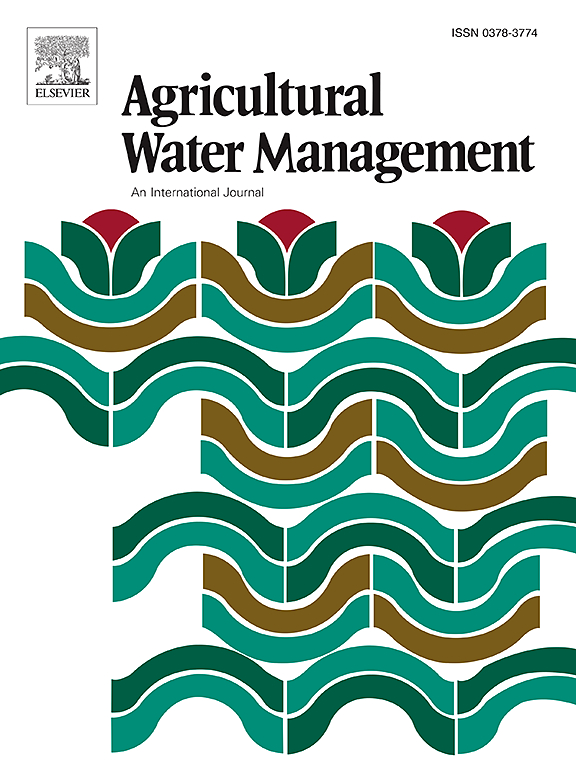Enhancing agricultural sustainability with water and crop management strategies in modern irrigation and drainage networks
IF 6.5
1区 农林科学
Q1 AGRONOMY
引用次数: 0
Abstract
Improving global food security hinges on achieving sustainable agricultural production within independent irrigation and drainage units, considering the availability of sustainable water resources. This study investigated the potential for enhancing the sustainability of agricultural production in a modern irrigation and drainage network (TIDN) area and evaluated the network's performance under various strategies. These strategies included mulching, transitioning from traditional to drip irrigation, combining mulching with drip irrigation (IDM), and reducing the crop yield gap. Utilizing 2009–2018 data and the AquaCrop model, which was both calibrated and validated, the green and blue water footprints (GWF and BWF) of dominant crops in the region's cropping pattern were assessed. The crop cultivation was prioritized based on the total and unit unsustainable BWF. The performance of TIDN was evaluated using indicators of reliability, vulnerability, system deficiency, flexibility, and sustainability. The drip irrigation had the most significant impact on reducing BWF, while mulching was more effective in decreasing GWF. The adoption of IDM led to a total annual water savings of 382.4 m3 ha−1. The 10-year average reductions in BWF from May to August ranged from 1.7 to 3.1 MCM, with approximately 88–93 % of these savings attributed to decreased water consumption in rice fields. Mulch, drip, and IDM decreased the BWF by 3.3 %, 9.4 %, and 10.2 %, respectively, compared to current conditions. The study revealed that the expansion of rice cultivation under conventional flooding irrigation was incompatible with the sustainable blue water resources available, and replacing rice with wheat could reduce the unsustainable BWF by 95–100 %. Compared to current conditions, IDM improved network sustainability by 1.2 %, while closing the yield gap improved the indicator by 24 %. The findings suggest that combining infrastructural solutions, such as updating irrigation systems, with farm management solutions, such as reducing crop yield gaps and implementing mulching, can significantly enhance the sustainability of production in intensively agricultural areas.
利用现代灌排网络中的水和作物管理策略提高农业可持续性
考虑到可持续水资源的可用性,提高全球粮食安全取决于在独立灌排单元内实现可持续农业生产。本研究调查了在现代灌排网络(TIDN)地区提高农业生产可持续性的潜力,并评估了该网络在各种策略下的表现。这些策略包括地膜覆盖、从传统灌溉过渡到滴灌、将地膜覆盖与滴灌相结合(IDM)以及缩小作物产量差距。利用 2009-2018 年的数据和经过校准和验证的 AquaCrop 模型,对该地区种植模式中主要作物的绿水足迹和蓝水足迹(GWF 和 BWF)进行了评估。根据不可持续的总生物耗水量和单位生物耗水量对作物种植进行了优先排序。使用可靠性、脆弱性、系统缺陷、灵活性和可持续性指标对滴灌网络的性能进行了评估。滴灌对减少生物耗水量影响最大,而地膜覆盖对减少全球耗水量更为有效。采用 IDM 后,年节水总量为 382.4 立方米/公顷-1。5 月至 8 月的 10 年平均生物需水量减少量在 1.7 至 3.1 百万立方米之间,其中约 88-93% 的节水量归因于稻田耗水量的减少。与当前情况相比,地膜覆盖、滴灌和 IDM 分别减少了 3.3%、9.4% 和 10.2%的 BWF。研究表明,在传统大水漫灌条件下扩大水稻种植与可持续的蓝色水资源不相容,用小麦替代水稻可将不可持续的生物耗水量降低 95%-100%。与当前条件相比,IDM 可将网络的可持续性提高 1.2%,而缩小产量差距则可将该指标提高 24%。研究结果表明,将基础设施解决方案(如更新灌溉系统)与农业管理解决方案(如缩小作物产量差距和实施地膜覆盖)相结合,可显著提高集约化农业地区生产的可持续性。
本文章由计算机程序翻译,如有差异,请以英文原文为准。
求助全文
约1分钟内获得全文
求助全文
来源期刊

Agricultural Water Management
农林科学-农艺学
CiteScore
12.10
自引率
14.90%
发文量
648
审稿时长
4.9 months
期刊介绍:
Agricultural Water Management publishes papers of international significance relating to the science, economics, and policy of agricultural water management. In all cases, manuscripts must address implications and provide insight regarding agricultural water management.
 求助内容:
求助内容: 应助结果提醒方式:
应助结果提醒方式:


